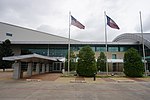Jetrail
Braniff Jetrail Fastpark System was a suspended monorail system that operated at Dallas Love Field in Dallas, Texas, United States, from April 18, 1970, until January 13, 1974. It was built by Stanray Corporation, Chicago, Illinois, for and operated by Braniff International Airways to transport passengers and their luggage from remote parking lots to the airport terminal. Jetrail was the world's first fully automated monorail transit system. The system, however, continued in operation when Braniff moved the majority of its operations to Dallas/Fort Worth International Airport on January 13, 1974. Braniff continued to operate intrastate service from Love Field to both Houston Hobby and San Antonio International Airports, to compete with Southwest Airlines, until September 1, 1974. At that time, all Jetrail operations ceased.
Excerpt from the Wikipedia article Jetrail (License: CC BY-SA 3.0, Authors).Jetrail
Herb Kelleher Way, Dallas
Geographical coordinates (GPS) Address Nearby Places Show on map
Geographical coordinates (GPS)
| Latitude | Longitude |
|---|---|
| N 32.837592 ° | E -96.842467 ° |
Address
Herb Kelleher Way
Herb Kelleher Way
75235 Dallas
Texas, United States
Open on Google Maps








